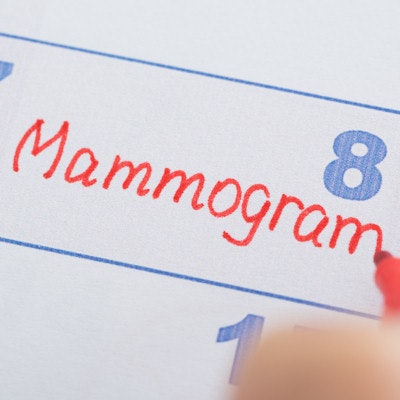
While high recall rates are considered one of the "harms" of mammography screening, a large-scale study published online April 3 in Radiology suggests that recall rates that are too low could lead to higher rates of interval cancers.
 Dr. Elizabeth Burnside from the University of Wisconsin.
Dr. Elizabeth Burnside from the University of Wisconsin.
"From a clinical perspective, our study shows that establishing a minimum recall rate is a reasonable and potentially important goal for breast cancer screening programs," Burnside said.
Effect of recall rates?
The research project stemmed from the observation that screening facilities with higher rates of recall for further investigation had higher cancer detection rates for screening exams, Duffy said.
"[However,] it was not known if this [higher recall rate] resulted in lower rates of symptomatic cancers thereafter," Duffy told AuntMinnie.com. "This project was designed to fill this gap."
There is consensus that a maximum recall threshold exists, Burnside noted, above which the benefits of screening mammography diminish relative to the added harms.
"However, far fewer studies have investigated the concept of a minimal recall rate below which potential benefits are lost," she said.
To explore whether a low recall rate -- also called the recall to assessment rate in the U.K. -- leads to more interval cancers, the researchers retrospectively analyzed 5,126,689 screening episodes conducted on women ages 50 to 70 between April 1, 2005, and March 31, 2008, at 84 screening facilities in England, Ireland, and Wales within the U.K. NHSBSP. They also collected outcomes data for a three-year period after the screening exams. The NHSBSP invites women to receive mammographic screening every three years, and it screens approximately 2 million women each year, according to the researchers.
The group found that 57,191 breast cancers were detected at follow-up during the study period, while 41,324 were diagnosed at screening and 15,867 were interval cancers. Of the 57,191 cancers, 47,309 (82.7%) were invasive cancers and 9,593 (16.8%) were ductal carcinoma in situ (DCIS). The other 289 cancers (0.5%) were missing a subtype designation.
Interval cancer rates
Overall, the NHSBSP had a recall for assessment rate of 4.56% (range: 1.64%-8.42%; standard deviation, 1.15%), an average cancer detection rate of 8.1 per 1,000 women screened, and an average interval cancer rate of 3.1 per 1,000 women screened.
The researchers then estimated the trade-off between recall rate and interval cancer rate by performing Poisson regression analysis on the data in aggregate, as well as by patient age and screening type. In aggregate, recall and interval cancer rates had a statistically significant negative association (p = 0.01), with 80 to 84 additional recalls required to avoid one interval cancer. This ratio varied based on age and other factors, however.
"Recall rate had more of an impact on interval cancer in patients who are older, demonstrating a slightly different 'value' in terms of the trade-off between recall rate and interval cancers," Burnside said.
| No. of screening recalls to detect 1 interval breast cancer | |
| Age group | No. of recalls |
| 50-54 | 89-96 recalls |
| 55-59 | No statistically significant association |
| 60-64 | 70-73 recalls |
| 65-69 | 55-58 recalls |
The researchers also found a statistically significant association between recall and interval cancer rates when analyzing data from both prevalent and incident cancer screening rounds:
- Incident screening: 79-83 recalls to detect one interval cancer
- Prevalent screening: 176-186 recalls to detect one interval cancer
"Our demonstration of the association between increasing [recall to assessment rate] and decreasing [interval cancer rate] supports the possibility of identifying a minimum [recall to assessment rate] as a benchmark that is immediately available and statistically stable," the authors wrote.
QA infrastructure
In addition to yielding data on the relationship between recall and interval cancer rates, the study also highlighted the benefits of a rigorous quality assurance (QA) infrastructure to help breast cancer screening programs learn from actual practice, Burnside said. The NHSBSP collects data that can be used to learn about screening and make informed decisions for the future, she said.
"The study underscores the crucial importance of comprehensive, accurate data collection of interval cancers in screening programs like the system in the U.K.," Burnside said.
Because the research focused on the U.K. NHSBSP, the findings on the specific trade-offs regarding recall rates are only directly applicable to that program. However, the researchers said their methods also provide an opportunity for other screening programs to determine the trade-offs of establishing a minimum recall to assessment rate based on their population and program characteristics.
"By establishing a relationship between recall rate and interval cancer rate and providing the methodology to document trade-offs, our results contribute a necessary foundation for determining a minimal recall rate threshold that maximizes value for women undergoing breast cancer screening," Burnside said. "Additional research has the potential to help determine a specific minimum threshold for recall rate for breast cancer screening programs."




















